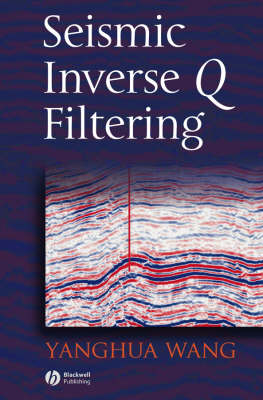
Seismic Inverse Q Filtering
Wiley-Blackwell (Verlag)
978-1-4051-8540-0 (ISBN)
- Titel ist leider vergriffen;
keine Neuauflage - Artikel merken
Seismic inverse Q filtering is a data processing technology for enhancing the resolution of seismic images. It employs a wave propagation reversal procedure that compensates for energy absorption and corrects wavelet distortion due to velocity dispersion. By compensating for amplitude attenuation, seismic data can provide true relative-amplitude information for amplitude inversion and subsequent reservoir characterization. By correcting the phase distortion, seismic data with enhanced vertical resolution can yield correct timings for lithological identification. This monograph presents the theory of inverse Q filtering and a series of algorithms, collected with the following selection criteria in mind: robustness, effectiveness and practicality.
The book is written for processing geophysicists who are attempting to improve the quality of seismic data in terms of resolution and signal-to-noise ratio, as well as for reservoir geophysicists who are concerned about seismic fidelity in terms of true amplitudes, true timings and true frequencies. It will also be particularly valuable as a guide for seasoned geophysicists who are attempting to develop seismic software for various research settings. Finally, it can be used as a reference work or textbook for postgraduate students in seismic and reservoir geophysics.
Professor Yanghua Wang is Director of the Centre for Reservoir Geophysics, Imperial College London. He is a Fellow of the Institute of Physics (FIntP) and a Fellow of the Royal Astronomical Society (FRAS). He is also a founding editor of the Journal of Geophysics and Engineering, and received the Bonarelli Award (2005) from the European Association of Geoscientists & Engineers.
Preface. 1. Introduction to inverse Q filtering.
1.1 The earth Q effect on seismic waves.
1.2 Inverse Q filters.
1.3 The effectiveness of inverse Q filtering.
Part I: Mathematical Q models.
2. Kolsky’s model for seismic attenuation and dispersion.
2.1 Kolsky’s attenuation-dispersion model.
2.2 Modification to the Kolsky model.
2.3 Accurate velocity dispersion correction.
2.4 Comparison with different Q models.
3. Mathematical definition of the earth Q models.
3.1 Mathematical definition of Q.
3.2 Kolsky’s Q model and the complex wavenumber.
3.3 The Strick–Azimi Q model.
3.4 Kjartansson’s constant-Q model.
3.5 Azimi’s second and third Q models.
3.6 Müller’s Q model.
3.7 The Zener or standard linear solid model.
3.8 The Cole–Cole Q model.
3.9 A general linear model.
Part II: Inverse Q filters.
4. Stabilized inverse Q filtering algorithm.
4.1 Basics of inverse Q filtering.
4.2 Numerical instability of inverse Q filtering.
4.3 Stabilized inverse Q filter.
4.4 Comparison with gain-limited inverse Q filter.
4.5 Comparison with a conventional inverse Q filter.
4.6 Synthetic and real data examples.
5. Inverse Q filtering for phase and amplitude separately.
5.1 Phase-only inverse Q filtering.
5.2 Amplitude-only inverse Q filtering.
5.3 Forward Q filtering.
5.4 Summary of inverse and forward Q filters by downward.
continuation.
5.5 Different stabilization schemes.
6. Layered implementation of inverse Q filters.
6.1 The layered approach to inverse Q filtering.
6.2 Inverse Q filtering within a constant-Q layer.
6.3 Phase- or amplitude-only inverse Q filtering.
6.4 Forward Q filtering.
6.5 Application of layered inverse Q filtering.
7. Inverse Q filtering in the Gabor transform domain.
7.1 Stabilized inverse Q filter.
7.2 The Gabor transform.
7.3 Inverse Q filtering by Gabor transform.
7.4 Forward Q filtering by Gabor transform.
7.5 An empirical formula for the stabilization factor.
8. The effectiveness of stabilized inverse Q filtering.
8.1 Inverse Q filtering of a land seismic section.
8.2 Flattening the amplitude spectrum and strengthening.
the relative amplitude.
8.3 Increasing the spectral bandwidth.
8.4 Improving the signal-to-noise ratio.
8.5 Enhancing seismic resolution.
8.6 Sensitivity of the resolution enhancement to Q values.
9. Migration with inverse Q filtering.
9.1 Inverse Q filtered migration in the wavenumberfrequency.
domain.
9.2 Stabilized migration with lateral variation in velocity.
and Q models.
9.3 The implicit finite-difference extrapolator in the spacefrequency.
domain.
9.4 Migration examples.
Part III: Q estimation.
10. Q estimation from vertical seismic profiling data.
10.1 The attenuation effect on VSP waveform.
10.2 Spectral ratio method for Q estimation.
10.3 The multitaper technique for spectral estimation.
10.4 Robust Q estimation from real VSP data.
11. Q analysis from reflection seismic data.
11.1 Q analysis based on amplitude attenuation.
11.2 Q analysis based on amplitude compensation.
11.3 Interval-Q calculation by linear inversion.
11.4 Q analyses on the P-P and P-SV wave sections.
12. Crosshole seismic tomography for the Q model.
12.1 Inverse theory for waveform tomography.
12.2 Issues in real data application.
12.3 Waveform inversion for the velocity model.
12.4 Waveform tomography for the attenuation model.
References.
Author index.
Subject index
| Erscheint lt. Verlag | 15.4.2008 |
|---|---|
| Verlagsort | Hoboken |
| Sprache | englisch |
| Maße | 160 x 238 mm |
| Gewicht | 535 g |
| Themenwelt | Naturwissenschaften ► Geowissenschaften ► Geologie |
| ISBN-10 | 1-4051-8540-6 / 1405185406 |
| ISBN-13 | 978-1-4051-8540-0 / 9781405185400 |
| Zustand | Neuware |
| Haben Sie eine Frage zum Produkt? |
aus dem Bereich


